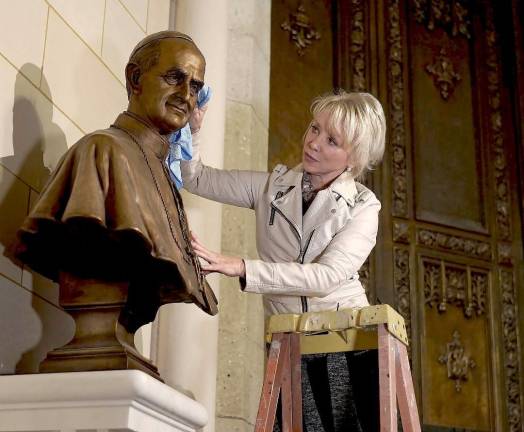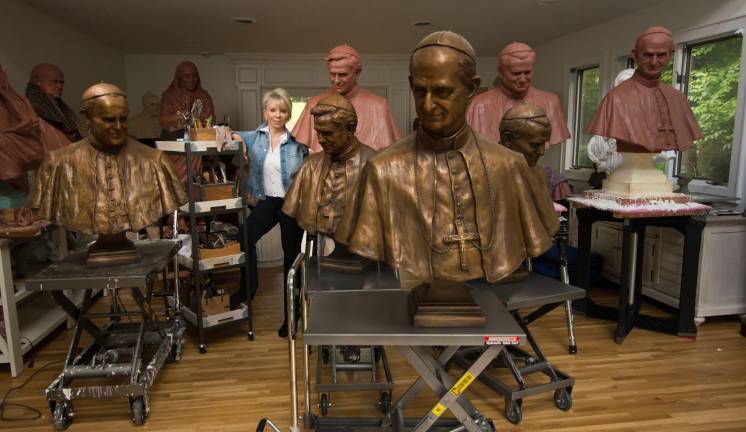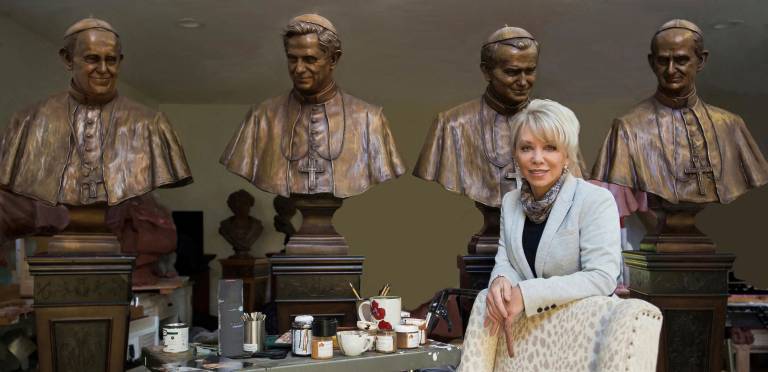Sculptor Carolyn Palmer breathes life into famous faces




By Ginny Privitar
CHESTER — The busts of four popes cast gazes from their stunning likenesses upon parishioners as they enter St. Patrick’s Cathedral.
Their creator is Carolyn D. Palmer, a Chester native and a graduate of John S. Burke Catholic High School in Goshen. She's now a famous sculptor with many commissions, and the four popes, ensconced eight feet high at the historic New York City church, are her most recent installation.
Two popes face to the left and two to the right. After installing the busts, Palmer watched as people entered the cathedral.
"One woman said, ‘I feel like they're alive and looking right at me,'" said Palmer. "That was the greatest reward I've gotten yet, the greatest feeling."
Palmer was first commissioned by private donors to sculpt a bust of Pope Francis for the Apostolic Nuncio’s mission to the United Nations. Pope Francis blessed the bust when he visited.
The Archdiocese of New York ordered another bust of Pope Francis for St. Patrick’s Cathedral. Soon afterward, Palmer was asked to sculpt the three other pontiffs who had also visited the cathedral: Benedict XVI, John Paul II, and Pope Paul VI.
When she learned the sculptures would be placed on a high shelf, and not at eye level, she re-sculpted the bust of Pope Francis so that he gazed down at visitors. She then followed suit with the other three busts.
Palmer aims for a lively realism.
“You can create a perfect model, yet it doesn’t come to life,” Palmer said. “It's more of a connection that comes from the soul, like music — like an actress would take on the part of the person.”
Palmer studies many photos and videos of the person she's sculpting. But she also tries "to sense that person."
"I try to treat it as though it’s the essence of the person," she said.
'Sculpting found me'It's surprising that, aside from a few high school and college classes, Palmer never studied with any other sculptors. She is fond of a quote by Oscar Wilde: “Art is not to be taught in Academies. It is what one looks at, not what one listens to, that makes the artist. The real schools should be the streets.”
“Sculpting was a part of me," Palmer said. "I didn’t find it. It found me.”
One of the commissions she's working on now is a sculpture of Supreme Court Justice Antonin Scalia for the National Italian American Foundation.
Palmer is also known for her Lucille Ball statue, installed in the late comedian's hometown of Celoron, N.Y. The first statute of Lucy, by another sculptor, was roundly criticized for looking nothing like her and was promptly nicknamed “Scary Lucy.” Palmer was asked to do her version, which is a resounding success.
She was also commissioned to do busts of Eleanor and Franklin Roosevelt, which are on display in the lobby of the President Franklin D. Roosevelt Presidential Library and Museum in Hyde Park as well as sculptures of Orville and Wilbur Wright for the Sanford/Orlando Airport.
Senator Tarky Lombardi Jr., former chair of the New York State Senate Committee on the Arts and Cultural Resources, said Palmer's Roosevelt sculptures "are almost human. In my estimation, these are the finest sculpture images of Franklin D. and Eleanor Roosevelt to be found anywhere in the world.”
It started at the beachAs a child, Palmer would make sand sculptures — not just castles — at the beach.
“I never thought they were that good, but people would make a big deal about them," she said. "I always had a propensity for people, figures and faces. As a little girl I was fascinated by that."
She took art in high school, mostly painting, drawing, and some architecture. She built a little house that won a ribbon and was noted in the paper. One of her teachers was Lorraine Tomasi, now 90 and living in Monroe. Tomasi gave Palmer an art medal upon her graduation in 1974.
“She was the best art student I had," Tomasi said. "She was very interesting to work with, and her vision was always bigger than what was in front of us.”
Palmer attended Wells College in Aurora, N.Y. At the time she thought she wanted to do medical illustrations. But during summer break she traveled to Europe, where she studied the art in galleries and museums. She knew then that sculpting was her future. She was especially drawn to the French sculptors Jean-Baptiste Carpeaux, and Jean-Antoine Houdon for the lifelike quality of their work.
After her trip to Europe, Palmer switched to Nazareth College in Rochester, where she took classes in painting and fiber art, and just one sculpture class. She was asked to sculpt a plaster hand holding a ball. Her work in the class was so good, the teacher said, “You've been doing this forever."
Palmer replied truthfully. "No, I haven't," she said.
Teachers recognized her talent but she wasn’t yet ready. She graduated cum laude with a bachelor of science degree and a concentration in art education.
Daring to do JeffersonPalmer has been sculpting professionally for almost 20 years, but her first foray into sculpting was a stroke of serendipity. While living in Syracuse, N.Y., Thomas Greenwood, owner of the Jefferson Center, asked her to paint an oil portrait of his son, Parker. While she was working on that, Greenwood asked Palmer to help find a sculptor to do a figure of Thomas Jefferson for the center. Palmer asked for the job herself. She offered to put up the money for the clays and the model, and, if Greenwood didn't like it, he didn't have to buy it.
She'd gone out on a limb. She didn't know where to start in creating a full, life-sized figure.
“I had no clue really and had to learn how to build a skeleton-like armature to build up the clays and then make a mold," she said.
As the sculpture took shape, Greenwood was excited about what he saw. The magnificent Jefferson statue — Palmer's first, full-sized sculpture — attracted attention.
“Doing Thomas Jefferson was intimidating, but I learned a lot from the first piece," Palmer said. "It was very daring to do that. It was quite an amazing experience for me, and other commissions came."
Palmer now lives in Saddle River, N.J., where she has her studio, but still maintains a small studio in Montgomery to be near the famed Polich Tallix Fine Art Foundry in Walden.
She visits the foundry frequently as her figures are being cast.
“I build an armature, build that up with foam stuffing and carve the foam and put clay on top and sculpt it bring out the figure and features," she said of her process. "I rotate the piece constantly once I have it in the clay."
Palmer is also starting a company, Palmer Sculptures, LLC, and expects to have a full inventory ready by spring.
For more information on Palmer's work, visit palmersculptures.com or email her at cdpalmer33@gmail.com.